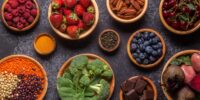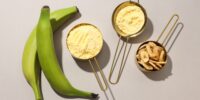Prebiotic Type Spotlight: Polyphenols
Last Updated September 2023
Each edition of GPA’s Prebiotic Spotlight focuses on a specific prebiotic type to raise awareness around the prebiotic itself, its sources, any notable and/or recent research, and how it is used in the marketplace. This edition’s spotlight is on polyphenols.
Overview
Polyphenols are a large class of plant-based organic compounds with one or more phenolic rings bearing hydroxyl groups in their chemical structure (Lippolis et al., 2023). Polyphenols constitute the fourth major ingredient in plants behind cellulose, hemicellulose, and lignin (Chen et al., 2022), with more than 8,000 phenolic compounds identified to date. Many of these phenolic compounds have complex chemical structures, contributing to their various biological functions (Lippolis et al., 2023). One of polyphenols’ many biological functions is their prebiotic activity through gut microbiome modulation, which then translates to numerous health benefits in the host (Li et al., 2023a; Lippolis et al., 2023).
Benefit Areas
When polyphenols were first classified as potential prebiotics in the International Scientific Association for Probiotics and Prebiotics (ISAPP) consensus paper (Gibson et al., 2017), little data was available. This has since increased over time. Now, polyphenols are known to have various health benefits associated with their prebiotic activity, including:
- Microbiome modulation towards health and wellness (Rodríguez-Daza et al., 2021).
- Neuroprotective benefits for age-related brain atrophy and cognitive performance (Chung et al., 2020; Kaplan et al., 2022; Nilsson et al., 2017).
- Urinary tract prophylactic benefits through antioxidant, anti-bacterial, and anti-inflammatory activities (González de Llano et al., 2020; Jin et al., 2023; Mena et al., 2017; Noce et al., 2021).
- Cardiometabolic benefits by improving cholesterol levels, arterial stiffness, and vascular function (Alves-Santos et al., 2020; Heiss et al., 2022; Le Sayec et al., 2022; Nilsson et al., 2017).
- Anti-adipogenic benefits through enzyme inhibition, modulation of glycemia and neurohormones related to food intake and satiety, and reducing visceral adiposity (Aloo et al., 2023; Kim et al., 2016; Yaskolka Meir et al., 2021; Zelicha et al., 2022).
- Anti-inflammatory, antioxidative, and immunomodulatory benefits in the gut, contributing to the management of inflammatory diseases including inflammatory bowel disease (Li et al., 2023b; Nunes et al., 2018; Recinella et al., 2022).
Sources
Polyphenols can be found in a variety of daily ingestible foods, including fruits, vegetables, cereals, olives, legumes, cocoa, tea, coffee, wine, beer, and grape pomace (Chen et al., 2022; Li et al., 2023a; Lippolis et al., 2023). Usually, less than 10% of polyphenols contained in a plant extract are absorbed in the small intestine and become bioavailable in the blood (Shabbir et al., 2021). This is due to the multi-drug efflux pumps that push them back into the gut after absorption (Scheepens et al., 2010). This contributes to their prebiotic potential as undigested polyphenols become available in the colon, modulating the gut microbiota, getting metabolized by the resident bacteria into absorbable metabolites (phenolics), which further modulate the gut microbiome environment or penetrate the body, providing complementary health benefits (Scheepens et al., 2010; Shabbir et al., 2021). Due to their low toxicity and broad-spectrum pharmacological potential, polyphenols are prime candidates for medical treatment, new drug development, and health care (Li et al., 2023a).
Dose Range
While a specific recommended daily dose has not been determined for polyphenols, some sources recommend a daily dose of 0.1 to 1.0 g (Bojarczuk & Dzitkowska-Zabielska, 2022). Generally, it is agreed that incorporating a diverse range of polyphenol-rich foods, including fruits, vegetables, whole grains, nuts, and seeds, as part of a balanced diet is essential for general health and well-being. Fruits such as grapes, apples, pears, cherries, and blueberries contain polyphenols at around 0.2 to 0.3 g per 100 g of fresh weight. In terms of experiencing health benefits, they have been reported at doses from 0.5 g to 1.5 g per day of polyphenols (Bojarczuk & Dzitkowska-Zabielska, 2022).
Recent Research
Polyphenols are widely researched, not only for their prebiotic effects, but also for their anti-inflammatory, immunomodulatory, and various biological actions. Currently, fifty-three studies on ClinicalTrials.gov are recruiting to use polyphenols in variable health conditions, including cardiovascular, metabolic, hepatic, neurological, skin, and healthy aging (ClinicalTrials.gov, 2023). On PubMed, searching “polyphenols” retrieved 4,079 results published in 2023 (PubMed, 2023a), but when “prebiotic polyphenols” were searched, the results came down to 46 (PubMed, 2023b). Grabež et al. (2022) performed a randomized, placebo-controlled trial investigating the effects of polyphenols on the outcomes of inflammatory factors and oxidative stress in patients with type 2 diabetes mellitus. Capsules containing 250 mg of pomegranate peel extract (PoPEx) were administered to the intervention group twice daily for eight weeks, which showed a significant reduction of inflammatory factors, oxidative stress biomarkers, and homocysteine compared to placebo. Additional analysis showed a significant inverse correlation between the reduction of all measured inflammatory markers (i.e., high sensitivity c-reactive protein, interleukin 6, and tumor necrosis factor α) and total antioxidant capacity (TAC) (Grabež et al., 2022). Another randomized, double-blinded, placebo-controlled, cross-over trial by Rehman et al. (2023) assessed the effects of a water-soluble tomato extract rich in secondary metabolites, including polyphenols, in overweight and obese adults. After four weeks of supplementation with 150 mg of the tomato extract twice daily, a significant reduction of fasting levels of plasma and urine trimethylamine-n-oxide (TMAO) was observed, which is known for its proatherogenic effects, via intestinal microbiota modulation.
How are polyphenols used in the marketplace?
Polyphenols have applications across diverse industries, including food and beverage, pharmaceutical and nutraceutical, and cosmetic and personal care. Polyphenols are known for their antioxidant properties, making them good candidates for food preservation (Rathee et al., 2023). They can also improve the physicochemical properties of starch such as gelatinization temperature, crystallization, and viscosity, and can reduce this polysaccharide’s degradation. Polyphenols are further used for the manufacture of food dyes, bioactive packaging, cosmetic products, paints, fertilizers, surfactants, textiles, rubber, plastics, curing agents, semi-conductors, and special machines, making them versatile innovation components for numerous technological and commercial applications (de Araújo et al., 2021).
The global market size for polyphenols was valued at $1.68 billion USD in 2022, with functional beverages dominating the application segments, followed by functional foods and dietary supplements, and a smaller share for cosmetics and toiletries, animal feed, dyes, and other applications (Grand View Research, 2023). The global polyphenol market size is expected to grow at a compound annual growth rate (CAGR) of 7.4% from 2023 to 2030, reaching $2.7 billion USD in 2030 (Allied Market Research, 2022).
References:
Allied Market Research. Polyphenol Market by Product Type (Apple, Green Tea, Grape Seeds and Others), Type (Flavonoid, Resveratrol, Phenolic Acid and Lignin), and Application (Functional Foods, Functional Beverages, Dietary Supplements, and Others): Global Opportunity Analysis and Industry Forecast 2021-2030. Retrieved on 2023 Jul 28. Available from: https://www.alliedmarketresearch.com/polyphenol-market
Aloo, S.-O., Ofosu, F. K., Kim, N.-H., Kilonzi, S. M., & Oh, D.-H. (2023). Insights on Dietary Polyphenols as Agents against Metabolic Disorders: Obesity as a Target Disease. Antioxidants, 12(2), 416. MDPI AG. Retrieved from http://dx.doi.org/10.3390/antiox12020416
Alves-Santos, A. M., Sugizaki, C. S. A., Lima, G. C., & Naves, M. M. V. (2020). Prebiotic effect of dietary polyphenols: A systematic review. Journal of Functional Foods, 74. https://doi.org/10.1016/j.jff.2020.104169
Bojarczuk, A., & Dzitkowska-Zabielska, M. (2022). Polyphenol Supplementation and Antioxidant Status in Athletes: A Narrative Review. Nutrients, 15(1), 158. https://doi.org/10.3390/nu15010158
Chen, J., Huang, Z., Cao, X., Zou, T., You, J., & Guan, W. (2022). Plant-derived polyphenols in sow nutrition: An update. Animal nutrition (Zhongguo xu mu shou yi xue hui), 12, 96–107. https://doi.org/10.1016/j.aninu.2022.08.015
Chung, J. Y., Jeong, J. H., & Song, J. (2020). Resveratrol Modulates the Gut-Brain Axis: Focus on Glucagon-Like Peptide-1, 5-HT, and Gut Microbiota. Frontiers in aging neuroscience, 12, 588044. https://doi.org/10.3389/fnagi.2020.588044
ClinicalTrials.gov. Retrieved on 2023 Jul 28. Available from: https://clinicaltrials.gov/search?term=polyphenols&aggFilters=status:rec&page=5
de Araújo, F. F., de Paulo Farias, D., Neri-Numa, I. A., & Pastore, G. M. (2021). Polyphenols and their applications: An approach in food chemistry and innovation potential. Food chemistry, 338, 127535. https://doi.org/10.1016/j.foodchem.2020.127535
Gibson, G. R., Hutkins, R., Sanders, M. E., Prescott, S. L., Reimer, R. A., Salminen, S. J., Scott, K., Stanton, C., Swanson, K. S., Cani, P. D., Verbeke, K., & Reid, G. (2017). Expert consensus document: The International Scientific Association for Probiotics and Prebiotics (ISAPP) consensus statement on the definition and scope of prebiotics. Nature reviews. Gastroenterology & hepatology, 14(8), 491–502. https://doi.org/10.1038/nrgastro.2017.75
González de Llano, D., Moreno-Arribas, M. V., & Bartolomé, B. (2020). Cranberry Polyphenols and Prevention against Urinary Tract Infections: Relevant Considerations. Molecules (Basel, Switzerland), 25(15), 3523. https://doi.org/10.3390/molecules25153523
Grabež, M., Škrbić, R., Stojiljković, M. P., Vučić, V., Rudić Grujić, V., Jakovljević, V., Djuric, D. M., Suručić, R., Šavikin, K., Bigović, D., & Vasiljević, N. (2022). A prospective, randomized, double-blind, placebo-controlled trial of polyphenols on the outcomes of inflammatory factors and oxidative stress in patients with type 2 diabetes mellitus. Reviews in cardiovascular medicine, 23(2), 57. https://doi.org/10.31083/j.rcm2302057
Grand View Research. Polyphenols Market Size, Share & Trends Analysis Report by Product (Grape Seed, Green Tea, Apple, Cocoa), By Application (Beverages, Food, Feed), By Region, And Segment Forecasts, 2023 – 2030. Retrieved on 2023 Jul 28. Available from: https://www.grandviewresearch.com/industry-analysis/polyphenols-market-analysis
Heiss, C., Istas, G., Feliciano, R. P., Weber, T., Wang, B., Favari, C., Mena, P., Del Rio, D., & Rodriguez-Mateos, A. (2022). Daily consumption of cranberry improves endothelial function in healthy adults: A double blind randomized controlled trial. Food & Function, 13(7), 3812–3824. https://doi.org/10.1039/d2fo00080f
Jin, Q., Liu, T., Qiao, Y., Liu, D., Yang, L., Mao, H., Ma, F., Wang, Y., Peng, L., & Zhan, Y. (2023). Oxidative stress and inflammation in diabetic nephropathy: role of polyphenols. Frontiers in immunology, 14, 1185317. https://doi.org/10.3389/fimmu.2023.1185317
Kaplan, A., Zelicha, H., Yaskolka Meir, A., Rinott, E., Tsaban, G., Levakov, G., Prager, O., Salti, M., Yovell, Y., Ofer, J., Huhn, S., Beyer, F., Witte, V., Villringer, A., Meiran, N., B Emesh, T., Kovacs, P., von Bergen, M., Ceglarek, U., Blüher, M., … Shai, I. (2022). The effect of a high-polyphenol Mediterranean diet (Green-MED) combined with physical activity on age-related brain atrophy: the Dietary Intervention Randomized Controlled Trial Polyphenols Unprocessed Study (DIRECT PLUS). The American journal of clinical nutrition, 115(5), 1270–1281. https://doi.org/10.1093/ajcn/nqac001
Kim, Y., Keogh, J. B., & Clifton, P. M. (2016). Polyphenols and Glycemic Control. Nutrients, 8(1), 17. https://doi.org/10.3390/nu8010017
Le Sayec, M., Xu, Y., Laiola, M., Gallego, F. A., Katsikioti, D., Durbidge, C., Kivisild, U., Armes, S., Lecomte, M., Fança-Berthon, P., Fromentin, E., Plaza Oñate, F., Cruickshank, J. K., & Rodriguez-Mateos, A. (2022). The effects of Aronia berry (poly)phenol supplementation on arterial function and the gut microbiome in middle aged men and women: Results from a randomized controlled trial. Clinical nutrition (Edinburgh, Scotland), 41(11), 2549–2561. https://doi.org/10.1016/j.clnu.2022.08.024
Li, L., Peng, P., Ding, N., Jia, W., Huang, C., & Tang, Y. (2023b). Oxidative Stress, Inflammation, Gut Dysbiosis: What Can Polyphenols Do in Inflammatory Bowel Disease? Antioxidants, 12(4), 967. https://doi.org/10.3390/antiox12040967
Li, S., Yin, S., Ding, H., Shao, Y., Zhou, S., Pu, W., Han, L., Wang, T., & Yu, H. (2023a). Polyphenols as potential metabolism mechanisms regulators in liver protection and liver cancer prevention. Cell proliferation, 56(1), e13346. https://doi.org/10.1111/cpr.13346
Lippolis, T., Cofano, M., Caponio, G. R., De Nunzio, V., & Notarnicola, M. (2023). Bioaccessibility and Bioavailability of Diet Polyphenols and Their Modulation of Gut Microbiota. International journal of molecular sciences, 24(4), 3813. https://doi.org/10.3390/ijms24043813
Mena, P., González de Llano, D., Brindani, N., Esteban-Fernández, A., Curti, C., Moreno-Arribas, M. V., Del Rio, D., & Bartolomé, B. (2017). 5-(3′,4′-dihydroxyphenyl)-γ-valerolactone and its sulphate conjugates, representative circulating metabolites of flavan-3-ols, exhibit anti-adhesive activity against uropathogenic escherichia coli in bladder epithelial cells. Journal of Functional Foods, 29, 275–280. https://doi.org/10.1016/j.jff.2016.12.035
Nilsson, A., Salo, I., Plaza, M., & Björck, I. (2017). Effects of a mixed berry beverage on cognitive functions and cardiometabolic risk markers; A randomized cross-over study in healthy older adults. PloS one, 12(11), e0188173. https://doi.org/10.1371/journal.pone.0188173
Noce, A., Di Daniele, F., Campo, M., Di Lauro, M., Pietroboni Zaitseva, A., Di Daniele, N., Marrone, G., & Romani, A. (2021). Effect of Hydrolysable Tannins and Anthocyanins on Recurrent Urinary Tract Infections in Nephropathic Patients: Preliminary Data. Nutrients, 13(2), 591. https://doi.org/10.3390/nu13020591
Nunes, S., Danesi, F., Del Rio, D., & Silva, P. (2018). Resveratrol and inflammatory bowel disease: the evidence so far. Nutrition research reviews, 31(1), 85–97. https://doi.org/10.1017/S095442241700021X
PubMed (a). Retrieved 2023 July 31. Available from: https://pubmed.ncbi.nlm.nih.gov/?term=polyphenols&filter=years.2023-2023
PubMed (b). Retrieved 2023 July 31. Available from: https://pubmed.ncbi.nlm.nih.gov/?term=prebiotic+polyphenols&filter=years.2023-2023
Rathee, P., Sehrawat, R., Rathee, P., Khatkar, A., Akkol, E. K., Khatkar, S., Redhu, N., Türkcanoğlu, G., & Sobarzo-Sánchez, E. (2023). Polyphenols: Natural Preservatives with Promising Applications in Food, Cosmetics and Pharma Industries; Problems and Toxicity Associated with Synthetic Preservatives; Impact of Misleading Advertisements; Recent Trends in Preservation and Legislation. Materials (Basel, Switzerland), 16(13), 4793. https://doi.org/10.3390/ma16134793
Recinella, L., Gorica, E., Chiavaroli, A., Fraschetti, C., Filippi, A., Cesa, S., Cairone, F., Martelli, A., Calderone, V., Veschi, S., Lanuti, P., Cama, A., Orlando, G., Ferrante, C., Menghini, L., Di Simone, S. C., Acquaviva, A., Libero, M. L., Nilofar, Brunetti, L., … Leone, S. (2022). Anti-Inflammatory and Antioxidant Effects Induced by Allium sativum L. Extracts on an Ex Vivo Experimental Model of Ulcerative Colitis. Foods (Basel, Switzerland), 11(22), 3559. https://doi.org/10.3390/foods11223559
Rehman, A., Tyree, S. M., Fehlbaum, S., DunnGalvin, G., Panagos, C. G., Guy, B., Patel, S., Dinan, T. G., Duttaroy, A. K., Duss, R., & Steinert, R. E. (2023). A water-soluble tomato extract rich in secondary plant metabolites lowers trimethylamine-n-oxide and modulates gut microbiota: a randomized, double-blind, placebo-controlled cross-over study in overweight and obese adults. The Journal of nutrition, 153(1), 96–105. https://doi.org/10.1016/j.tjnut.2022.11.009
Rodríguez-Daza, M. C., Pulido-Mateos, E. C., Lupien-Meilleur, J., Guyonnet, D., Desjardins, Y., & Roy, D. (2021). Polyphenol-Mediated Gut Microbiota Modulation: Toward Prebiotics and Further. Frontiers in nutrition, 8, 689456. https://doi.org/10.3389/fnut.2021.689456
Scheepens, A., Tan, K., & Paxton, J. W. (2010). Improving the oral bioavailability of beneficial polyphenols through designed synergies. Genes & nutrition, 5(1), 75–87. https://doi.org/10.1007/s12263-009-0148-z
Shabbir, U., Rubab, M., Daliri, E. B., Chelliah, R., Javed, A., & Oh, D. H. (2021). Curcumin, Quercetin, Catechins and Metabolic Diseases: The Role of Gut Microbiota. Nutrients, 13(1), 206. https://doi.org/10.3390/nu13010206
Yaskolka Meir, A., Rinott, E., Tsaban, G., Zelicha, H., Kaplan, A., Rosen, P., Shelef, I., Youngster, I., Shalev, A., Blüher, M., Ceglarek, U., Stumvoll, M., Tuohy, K., Diotallevi, C., Vrhovsek, U., Hu, F., Stampfer, M., & Shai, I. (2021). Effect of green-Mediterranean diet on intrahepatic fat: the DIRECT PLUS randomised controlled trial. Gut, 70(11), 2085–2095. https://doi.org/10.1136/gutjnl-2020-323106
Zelicha, H., Kloting, N., Kaplan, A., Yaskolka Meir, A., Rinott, E., Tsaban, G., Chassidim, Y., Bluher, M., Ceglarek, U., Isermann, B., Stumvoll, M., Quayson, R. N., von Bergen, M., Engelmann, B., Rolle-Kampczyk, U. E., Haange, S. B., Tuohy, K. M., Diotallevi, C., Shelef, I., Hu, F. B., … Shai, I. (2022). The effect of high-polyphenol Mediterranean diet on visceral adiposity: the DIRECT PLUS randomized controlled trial. BMC medicine, 20(1), 327. https://doi.org/10.1186/s12916-022-02525-8




